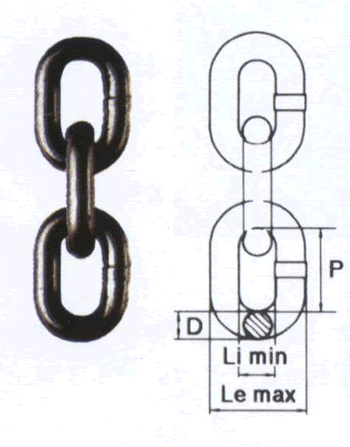Our staff will contact you within 12 hours, You can also contact us through the following ways:
Contact US WhatsApp: +8618766656705
- Email: [email protected]
- Tel: +8618766656705
- Web: https://www.toponechain.com/
The lifting chain is an indispensable and important picking device for the crane. The length of the chain can be adjusted according to the lifting height of the lifting object, which plays an important role in improving the working efficiency of the crane and expanding the working range of the crane .
Lifting chain structure diagram

Among similar products, the lifting chain is divided into the chain product series according to the basic structure of the chain, that is, the shape of the components, the parts and parts that mesh with the chain, and the size ratio between the parts.
1. Types of lifting chains
In the same chain products, the varieties are divided according to the material used for the chain elements, the form of chain accessories and the hinge structure.
2. Lifting Chain Specifications
Chains of the same variety are divided into different specifications according to pitch, number of rows, chain width and ultimate tensile load
Explanation of the distinction of overweight chains
1. Transmission chain: a chain mainly used to transmit power.
2、Conveyor chain: a chain mainly used for conveying materials.
3、Traction chain: a chain mainly used for pulling and lifting.
4、Special special chains: chains with special functions and structures mainly used on special mechanical devices.
Product testing
Visual inspection of chains
1. Whether the inner/outer chain piece is deformed, cracked or embroidered;
2. Whether the pin is deformed or rotated, embroidered or corroded;
3. Whether the roller is cracked, damaged or excessively worn;
4. Whether the joint is loose and deformed;
5. Whether there is abnormal sound or abnormal vibration during operation, and whether the chain lubrication condition is good.
Chain Accuracy Measurement Method
1. The chain is cleaned before measurement;
2. Encircle the chain under test on the two sprockets, and the upper and lower sides of the chain under test should be supported;
3. Before the measurement, the chain should stay for 1min under the state of applying one third of the minimum tensile load;
4. When measuring, apply the specified measuring load on the chain to tension the upper and lower chains, and the chain and the sprocket should ensure normal meshing;
5. Measure the center distance of the two sprockets
Measuring chain elongation
1. In order to remove the play of the entire chain, it should be measured under a certain degree of tension on the chain;
2. When measuring, in order to minimize the error, measure at the place of section 6-10 (link);
3. Measure the dimensions of the inner L1 and outer L2 between the rollers of the number of sections to obtain the judgment dimension L=(L1+L2)/2;
4. Find the elongation length of the chain. This value is compared with the limit value of the chain elongation in the previous item: Elongation of the chain = Judgment size - reference length / reference length * 100%
Reference length = chain pitch * number of knots
Chain scrap judgment
1. The allowable wear value of the hanging chain shall not exceed 10% of the diameter of the circular chain bar or the thickness of the auxiliary equipment;
2. Calculated from the plane where the main ring is not bent, if the main ring is twisted more than 10 degrees, it should be scrapped;
3. It is forbidden to use if any part of the hanging chain has cracks, bending or twisting, and the ring hinge is stuck or stiff, and cannot be ruled out;
4. The permanent elongation of both the chain and the single ring shall not exceed 5% of the original length .
Maintenance
1. The sprocket should be mounted on the shaft without skew and wobble. In the same transmission assembly, the end faces of the two sprockets should be in the same plane. When the center distance of the sprockets is less than 0.5 meters, the allowable deviation is 1 mm; when the center distance of the sprockets is more than 0.5 meters, the allowable deviation is 2 mm. However, the phenomenon of friction on the side of the sprocket teeth is not allowed. If the two-wheel knitting is too large, it will easily cause off-chain and accelerated wear. Care must be taken to check and adjust the offset when replacing sprockets.
2. The tightness of the lifting chain should be appropriate, too tight will increase power consumption, and the bearing will be easy to wear; The tightness of the chain is: lifted or pressed from the middle of the chain, the center distance of the two sprockets is about 2%-3%.
3. If the new lifting chain is too long or stretched after use, it is difficult to adjust. You can remove the chain links according to the situation, but it must be an even number. The links should pass through the back of the chain with the cleats inserted outside, and the openings of the cleats should face the opposite direction of rotation.
4. When the sprocket is seriously worn, the new sprocket and new chain should be replaced at the same time to ensure good meshing. You can't just replace a new chain or a new sprocket alone. Otherwise, it will cause poor meshing and accelerate the wear of the new chain or the new sprocket. After the sprocket tooth surface is worn to a certain extent, it should be turned over and used in time (referring to the sprocket used for the adjustable surface). to extend the usage time.
5. The old hoisting chain cannot be mixed with part of the new chain, otherwise it will easily cause shock during transmission and break the chain.
6. Remember to add lubricating oil to the lifting chain in time during work. The lubricating oil must enter the matching clearance of the roller and the inner sleeve in order to improve working conditions and reduce wear.